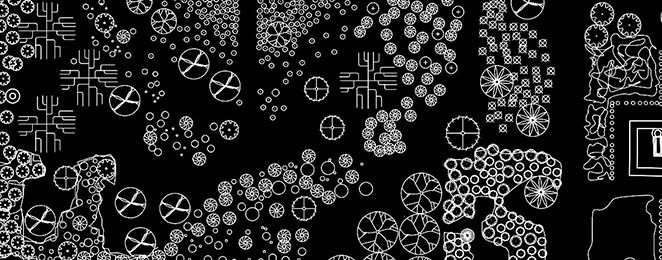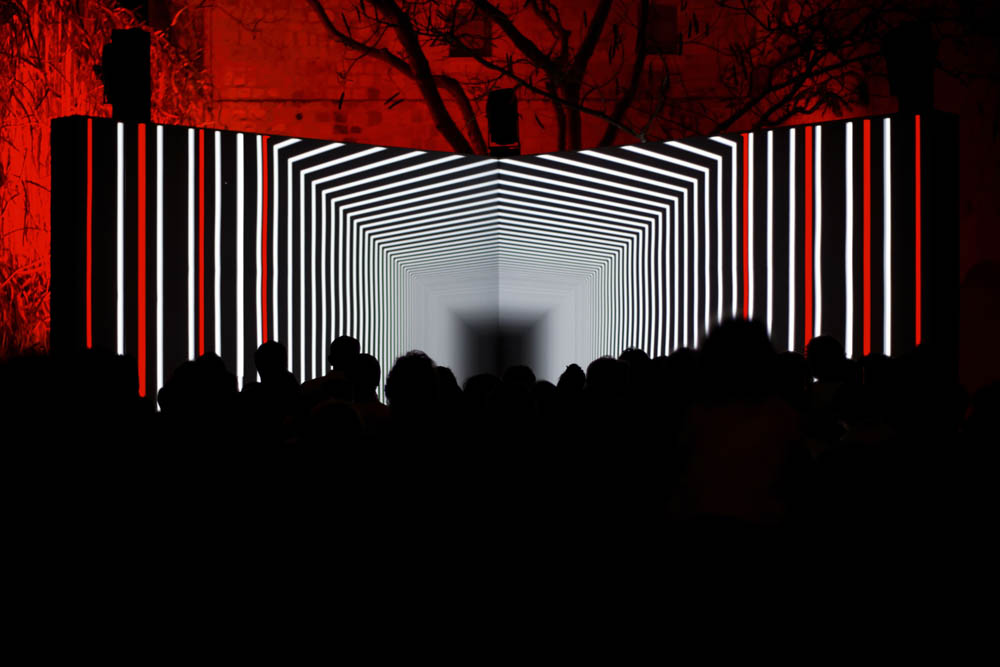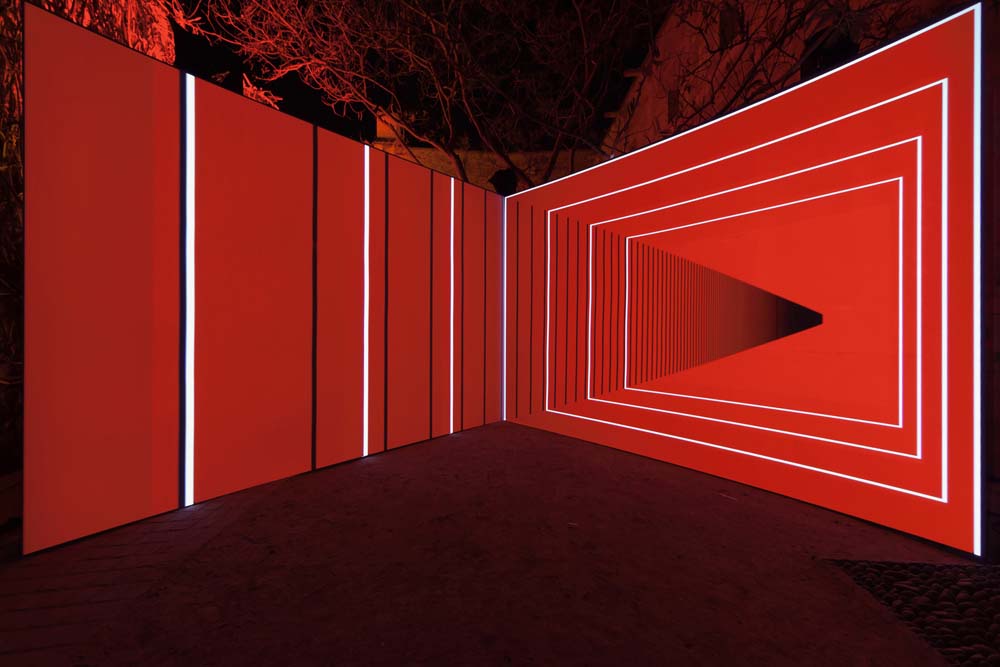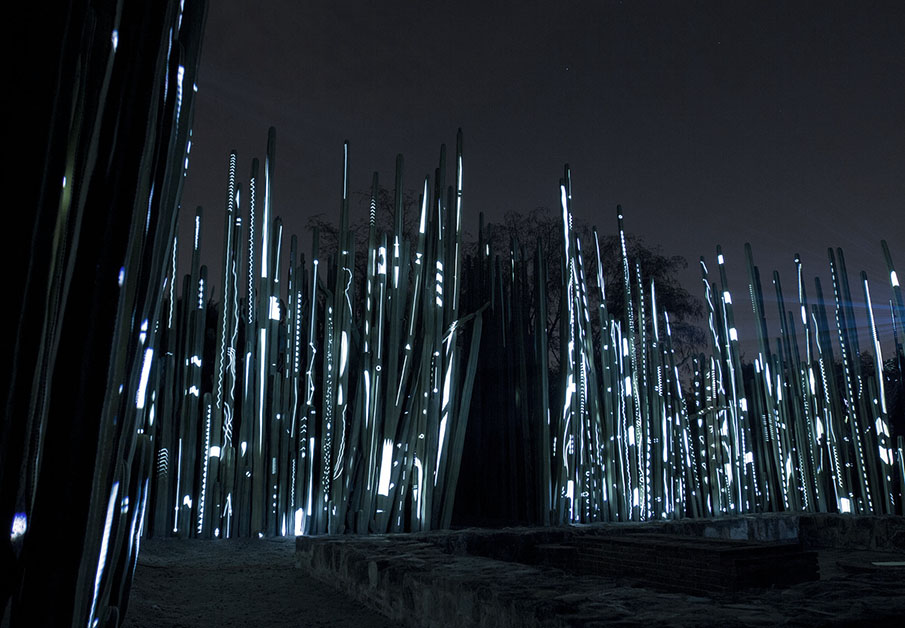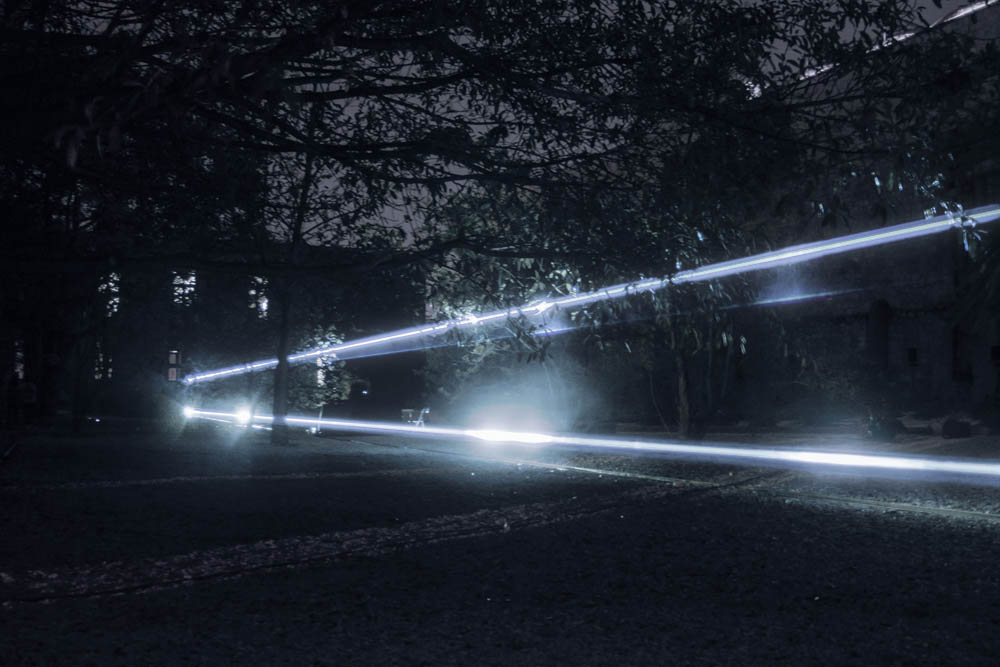Magic Geography
Magic Geography
The series of site specific visual and sonic installations created by several artists of the ANTIVJ visual label on the invitation of PROYECTA Oaxaca, international festival of design & digital arts, as part of the Ethnobotanical garden of Oaxaca, Mexico, explores the mediation between the natural and the artificial. Light follows the organic behavior of plants and creates depths of the perceptual field in order to vivify a lively dialogue between computer-generated elements and the natural world.
While gardens are an expression of the relationship between nature and culture, mostly seen as an idealized landscape subjected to the shaping powers of culture and deprived of their own principles of ecology, the garden in Oaxaca seems untameable. Its wild diversity is an image of all ethnic groups, indigenous languages and species of plants that found here a favourable oasis. The arrangement of the garden reflects the natural history of cultivation and creates a polemical encounter between the garden’s rather “nationalist” character and the arched windows of the monastery, an expression of alien colonists. The location turns into a living canvas and mediates our contemplation on the relationship with nature, environment, the passage of time, the spectres of being and our illuminating beliefs.
The garden in Oaxaca is a microcosm the artists use to unveil the region’s endemic flora and to create a continuous experience out of the artistic format, one that may enables visitors to gain a deeper understanding of human interaction with the environment.
“We liked the idea of trying to create a trail” says Nicolas Boritch, “(…) of developing an ephemeral experience in such a unique space. A place which had never been opened to the public at night before.”
The artists’ use of an immersive experience through several site specific installations generates a physical and psychological journey, but it also transforms materials and the environment into a magic geography where matter becomes object and space is refined as a wild territory of organic forms, light and technology. The trails of light become trails of the senses through which visitors can resonate with ancestral techniques, nature, technology, and a mystical experience of the world. While the curative mythologies and practices man creates to ensure his grasp over nature are an attempt to command its wild forces, the artists were interested “in letting the spectators glimpse and hear the hidden world behind each plant, rock and construction there”, says Thomas Vaquié. “We approached this idea of a garden trail as a dream. Even though each piece could work separately, it was important for us to build the trail as a journey, so that people might enter and exit with a sense of continuity. To give them the impression that they never left the dream.”
The succession of installations unveils the layered perception of space and dimension. In Olivier Ratsi’s Onion Skin, the physical dimension of the two walls positioned at right angles is augmented by light projections. The resemblence to a half-open book is an invitation to a journey through its chapters, but it is also a psychological preparation for the garden trail. “Onion Skin is based on the principle of alignment”, says Ratsi. “In our case, the alignment of three points: the module, the projection and the audience. When the spectator is perfectly aligned with the other two, a new dimension is revealed through anamorphosis.” The installation is a light graphology that reveals the progressive structure of space, time and perception through various recompositions. Repetition and scale are used to create a physical, hypnotic and dream-like experience based on geometric elements, the illusion of a new dimension and a play of light spectres. A 5.1 surround sound set-up accentuates the physical dimension and creates volume to this perspective. Like a door unto the realm of a parallel world, Onion Skin guides the visitors through the garden, where small installations are spread out across the paths that lead to the yet-unseen The Ark.
Romain Tardy’s cacti piece creates a cultural and symbolic bridge linking heterogeneous moments into a shared continuum. As the visitor approaches the installation, he is progressively immersed into its core, where shapes of light and whispering sounds draw him towards the main scene. The architectural setting, “formed by cacti which separated the space into two unavoidable chambers of perception, allows the visitors to view the installation from different angles”, says Laurent Delforge. “The idea of playing with multi-sided space became a thread in the narrative construction of the piece.”
The Ark is a contextual installation. It uses plants as a visual canvas but also as living beings embodying an individual presence coherently integrated into nature as the unity of multiple living entities. Yet the installation was not an attempt to reach “a pristine symbiosis between nature and technology”, says Delforge. “The idea was more to create a peculiar encounter.” The trail of light is an expression of the collision between nature and technology, but its luminous matter also deals with memory and recollection. The magic of light activates our recollection. Immersed in this environment, the visitor takes an illuminating mental journey to regain memory as light.
As visitors walk past the cacti installation, guided by distant lowing lights and subterranean sounds only, an open space reveals 3Destruct | Oaxaca pulsating behind thick vegetation.

The last piece, Réplica, which is set along a straight and rocky path going to the exit, acts as a recollection, using sonic textures and musical parts previously heard along the trail. The garden thus transforms into a magic place of illumination. It spotlights the history of the place, with plants being arranged by ecological and cultural themes, but it also enlightens a personal, curative experience.
The artists create a magic geography on the border between dream, psychedelia and an elevated state of consciousness. It is based on a play with scales, light and matter that reflects upon natural, archetypal and constructed forms. Yet it is hard to describe this work singularly. As Manuel Alacala, Proyecta’s content director, justly observes, it is something visceral that goes beyond experimental cinema and could rather define terms such as future film. The journey through the magic garden is a physical and imaginary exploration of a layered space and multiple experiences through which visitors reach refined mental geographies.
Text by Sabin Bors, curator at anti-utopias.com
The trail consisted of the following four works:
Onion Skin, by Olivier Ratsi, music by Thomas Vaquié
The Ark, by Romain Tardy & Squeaky Lobster
3Destruct | Oaxaca, by Yannick Jacquet, Thomas Vaquié & Jeremie Peeters
Réplica, by Laurent Delforge & Thomas Vaquié
All projects managed by Nicolas Boritch
Proyecta festival:
Content director: Manuel Alcala
Producer: Samuel Rivera
Technical director: Azael Saenz
Comments
Powered by Facebook Comments

